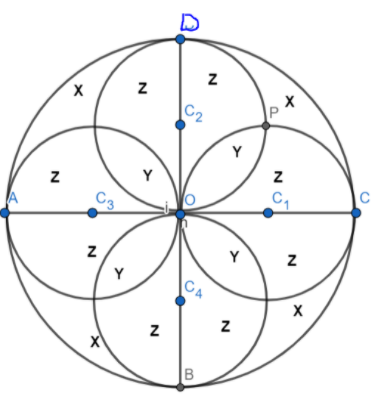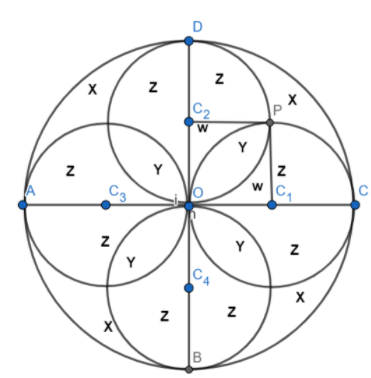
ABCD is a circle and circles are drawn with AO, CO, DO, and OB as diameters. Areas “X” and “Y” are labeled, what is the value of

A). 1
B).
C).
D).

Answer
498.9k+ views
Hint: As you see from the figure all areas had been marked. The first thing that you have to consider the areal symmetry of the circle. But the only problem is the portion in the
Complete step-by-step solution:

Here we introduce a new areal portion “w”
First , see the point P , and join
After joining “
Now suppose that the radius of the big circle is “2a” unit.
so the radius of the small circle is “a” unit. {as mentioned in the question}.
As you may know, a circle whose radius is “r “ unit has an area
In this way , we can calculate the area of big and small circle ,
Area of big circle :
Similarly area of small circle is :
As see from the figure we have to consider only
Now we calculate the area of the square
so the length of each side of the square is “a” unit . So the area will be
Now join
The area of each half circle will be
Here we “w” is the area of the portion of half-circle and “y” is the area of closed-loop of OP.
Next , we will try to formulate the linear equation ,
after substituting the value from (2) and put it on (1) ,we get
To get the value x we need to solve following equation ,
This implies
Hence option (a) is correct.
Note: Please do not try to use the method of definite integral, by assuming the equation of the circle. In order to apply, we have to assume the coordinate and equation of the circle, solving, and manipulating this type of equation is a very tedious process.
Complete step-by-step solution:

Here we introduce a new areal portion “w”
First , see the point P , and join
After joining “
Now suppose that the radius of the big circle is “2a” unit.
so the radius of the small circle is “a” unit. {as mentioned in the question}.
As you may know, a circle whose radius is “r “ unit has an area
In this way , we can calculate the area of big and small circle ,
Area of big circle :
Similarly area of small circle is :
As see from the figure we have to consider only
Now we calculate the area of the square
so the length of each side of the square is “a” unit . So the area will be
Now join
The area of each half circle will be
Here we “w” is the area of the portion of half-circle and “y” is the area of closed-loop of OP.
Next , we will try to formulate the linear equation ,
after substituting the value from (2) and put it on (1) ,we get
To get the value x we need to solve following equation ,
This implies
Hence option (a) is correct.
Note: Please do not try to use the method of definite integral, by assuming the equation of the circle. In order to apply, we have to assume the coordinate and equation of the circle, solving, and manipulating this type of equation is a very tedious process.
Latest Vedantu courses for you
Grade 8 | CBSE | SCHOOL | English
Vedantu 8 CBSE Pro Course - (2025-26)
School Full course for CBSE students
₹45,300 per year
Recently Updated Pages
Master Class 9 General Knowledge: Engaging Questions & Answers for Success

Master Class 9 English: Engaging Questions & Answers for Success

Master Class 9 Science: Engaging Questions & Answers for Success

Master Class 9 Social Science: Engaging Questions & Answers for Success

Master Class 9 Maths: Engaging Questions & Answers for Success

Class 9 Question and Answer - Your Ultimate Solutions Guide

Trending doubts
Where did Netaji set up the INA headquarters A Yangon class 10 social studies CBSE

A boat goes 24 km upstream and 28 km downstream in class 10 maths CBSE

Why is there a time difference of about 5 hours between class 10 social science CBSE

The British separated Burma Myanmar from India in 1935 class 10 social science CBSE

The Equation xxx + 2 is Satisfied when x is Equal to Class 10 Maths

What are the public facilities provided by the government? Also explain each facility




